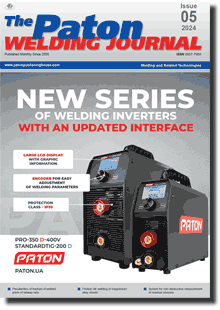| 2024 №05 (07) |
DOI of Article 10.37434/tpwj2024.05.01 |
2024 №05 (02) |

The Paton Welding Journal, 2024, #5, 3-10 pages
Peculiarities of fracture of welded joints of railway rails of oxygen-converter K76F steel
V.I. Shvets, I.V. Ziakhor, L.M. Kapitanchuk, O.V. Didkovsky, E.V. Antipin
E.O. Paton Electric Welding Institute of the NASU. 11 Kazymyr Malevych Str., 03150, Kyiv, Ukraine. E-mail: zyakhor2@ukr.netAbstract
The fracture surface of rail K76F steel after static bending tests of rail butt joints produced by flash-butt welding was studied. Butt joints of rails of individual batches were fractured on the base metal or heat-affected-zone. It is shown that in the regions of dark color and oval shape, the destruction of the iron oxide film takes place. The formation of films occurs as a result of flashing and spreading of iron oxide inclusions along the structural boundaries probably in the thermo-deformation conditions of the crimping shop at the stage of blooming production. The formation of clusters of iron oxides occurs during the crystallization of the residual melt in steel ingots with an insufficient degree of deoxidation. Oval regions of dark color on the surface of the fracture are evidence of an insufficient degree of deoxidation of rail steel and a factor of its quality reduction. Ref.12, Tabl.1, Fig. 10
Keywords: rail K76F steel, deoxidation, flash-butt welding, iron oxide
Received: 07.03.2024
Received in revised form: 09.04.2024
Accepted: 27.05.2024
References
1. Botshtein, V. A., Rudyuk, A. S., Chichkarev, E.A. et al. (2013) Mastering of converter rail steel production at PJSC MK Azovstal, Metall i Litiyo Ukrainy, 241(6), 34-37.2. (2016) TUU 27.1-40075815-002:2016: Rails are new welded for railways.
3. Kuchuk-Yatsenko, S.I., Didkovsky, O.V., Bogorsky, M.V. еt al. (2002) Method of flash-butt welding. Pat. 46820 Ukraine, 6 В23К11/04, С2. Publ. 06/17/2002 [in Ukrainian].
4. Kuchuk-Yatsenko, S.I., Didkovsky, O.V., Antipin, Ye.V. et al. (2016) Flash-butt welding of high-strength rails, mining - informatics. Automation and Electrical Eng., 528(4), 40-48. https://doi.org/10.15407/tpwj2016.06.01
5. Samoilovich, Yu.A. (1983) System analysis of ingot crystallization. Kyiv, Naukova Dumka [in Russian].
6. Barabash, O.M., Koval, Yu.N. (1986) Crystal structure of metals and alloys: Reference. Kyiv, Naukova Dumka [in Russian].
7. (1985) Atlas of slags: Reference. Ed. by I.S. Kulikova. Moscow, Metallurgiya [in Russian].
8. Levchenko, N.V. (2006) Variation of non-metallic inclusions during rail production. Metallurgical and Mining Industry, 2, 63-65.
9. Kuchuk-Yatsenko, S.I., Shvets, V.I., Didkovsky, A.V. et al. (2016) The influence of non-metallic inclusions of rail steel on the formation of a welded joint. The Paton Welding J., 5-6, 28-33. https://doi.org/10.15407/tpwj2016.06.01
10. Shvets, V.I., Ziakhor, I.V., Kapitanchuk, L.M. (2023) Features of formation and transformation of oxides in flashbutt welding of K76F rails. The Paton Welding J., 7, 16-24. https://doi.org/10.37434/tpwj2023.07.02
11. Gubenko, S.I. (2015) Nonmetallic inclusions and strength of steels. Palmarium Academic Publ.
12. Trotsan, A.I., Kaverinsky, V.V., Koshule, I.M., Nosochenko, A.O. (2013) On the factors influencing the quality of rail steel and rails. Metall i Litiyo Ukrainy, 241(6), 9-14.
Suggested Citation
V.I. Shvets, I.V. Ziakhor, L.M. Kapitanchuk, O.V. Didkovsky, E.V. Antipin (2024) Peculiarities of fracture of welded joints of railway rails of oxygen-converter K76F steel. The Paton Welding J., 05, 3-10.The cost of subscription/purchase order journals or individual articles
| Journal/Currency | Annual Set | 1 issue printed |
1 issue |
one article |
| TPWJ/USD | 384 $ | 32 $ | 26 $ | 13 $ |
| TPWJ/EUR | 348 € | 29 € | 24 € | 12 € |
| TPWJ/UAH | 7200 UAH | 600 UAH | 600 UAH | 280 UAH |
| AS/UAH | 1800 UAH | 300 UAH | 300 UAH | 150 UAH |
| AS/USD | 192 $ | 32 $ | 26 $ | 13 $ |
| AS/EUR | 180 € | 30 € | 25 € | 12 € |
| SEM/UAH | 1200 UAH | 300 UAH | 300 UAH | 150 UAH |
| SEM/USD | 128 $ | 32 $ | 26 $ | 13 $ |
| SEM/EUR | 120 € | 30 € | 25 € | 12 € |
| TDNK/UAH | 1200 UAH | 300 UAH | 300 UAH | 150 UAH |
| TDNK/USD | 128 $ | 32 $ | 26 $ | 13 $ |
| TDNK/EUR | 120 € | 30 € | 25 € | 15 € |
AS = «Automatic Welding» - 6 issues per year;
TPWJ = «PATON WELDING JOURNAL» - 12 issues per year;
SEM = «Electrometallurgy Today» - 4 issues per year;
TDNK = «Technical Diagnostics and Non-Destructive Testing» - 4 issues per year.


